Report: Effective Communication Strategies in Multinational Orgs
VerifiedAdded on 2023/06/12
|15
|5195
|482
Report
AI Summary
This report provides an overview of a multinational organization's communication challenges, focusing on social media, feedback, and intercultural communication. It identifies issues such as ineffective social media management, lack of quality feedback, and inadequate intercultural communication strategies. The report analyzes the impact of these issues on the organization's performance in the international market, referencing relevant literature. It concludes with recommendations for improving social media engagement, enhancing feedback mechanisms, and fostering better intercultural communication to facilitate growth and success in the global business environment. The report aims to assist managers in addressing these challenges and improving overall organizational effectiveness. Desklib provides access to similar solved assignments and study resources for students.
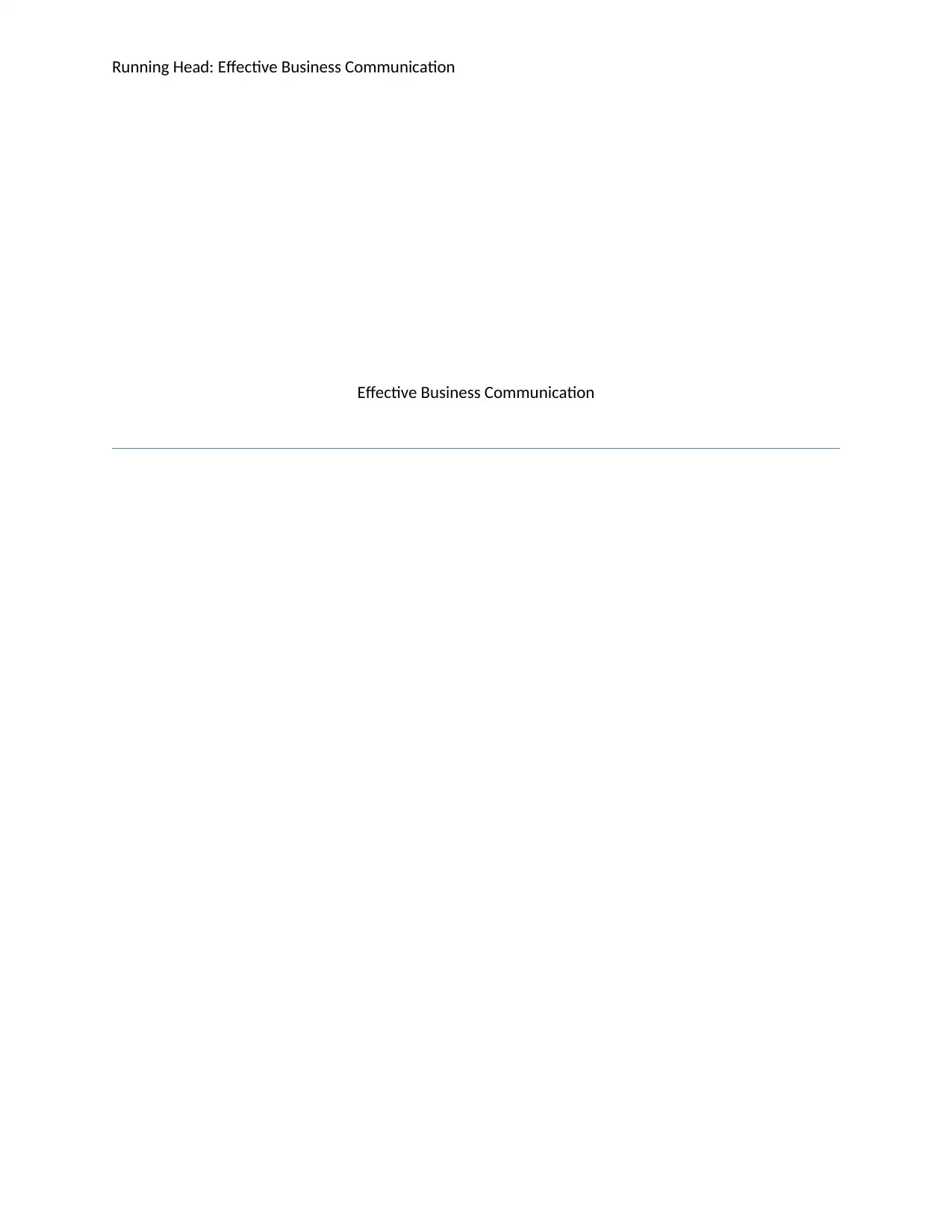
Running Head: Effective Business Communication
Effective Business Communication
Effective Business Communication
Paraphrase This Document
Need a fresh take? Get an instant paraphrase of this document with our AI Paraphraser
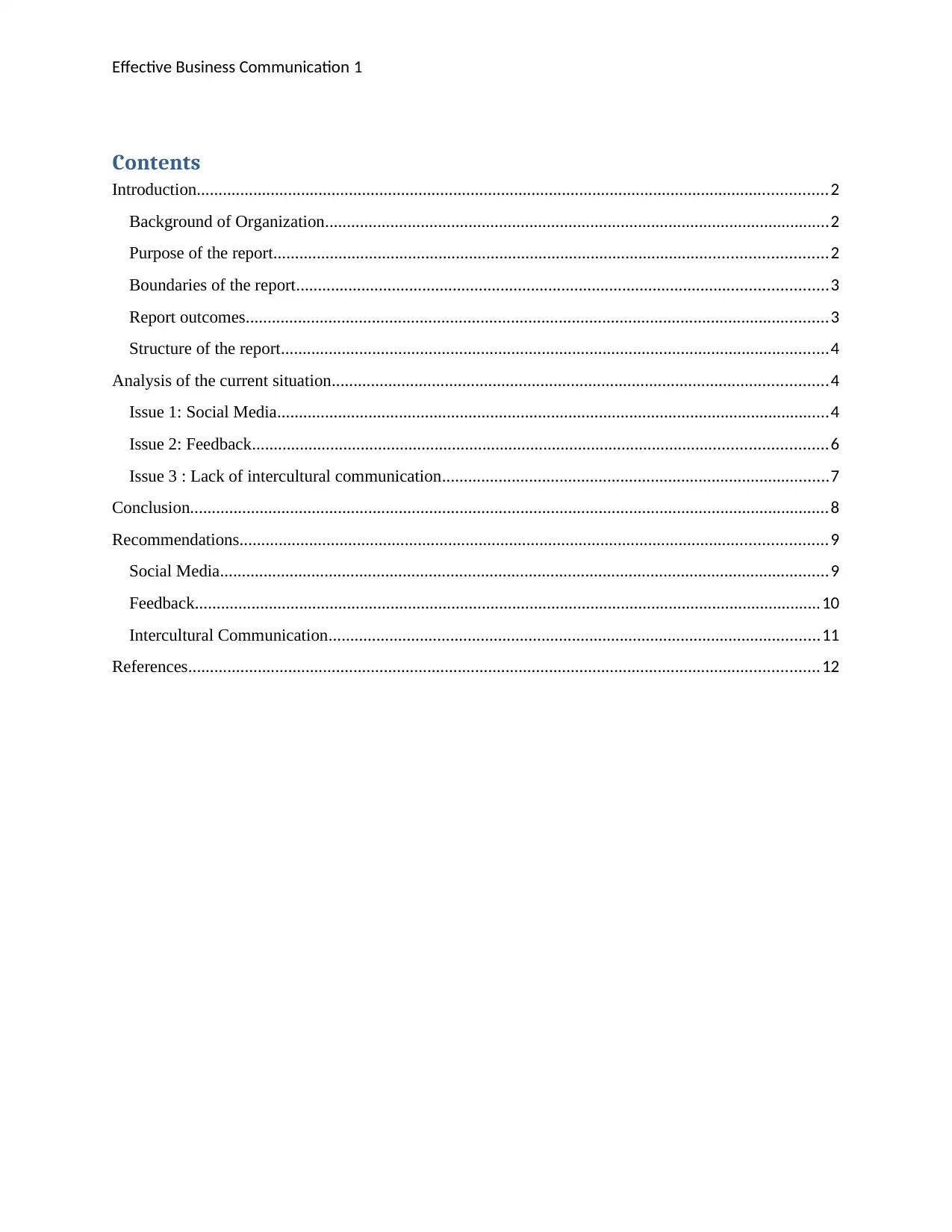
Effective Business Communication 1
Contents
Introduction.................................................................................................................................................2
Background of Organization....................................................................................................................2
Purpose of the report...............................................................................................................................2
Boundaries of the report..........................................................................................................................3
Report outcomes......................................................................................................................................3
Structure of the report..............................................................................................................................4
Analysis of the current situation..................................................................................................................4
Issue 1: Social Media...............................................................................................................................4
Issue 2: Feedback....................................................................................................................................6
Issue 3 : Lack of intercultural communication.........................................................................................7
Conclusion...................................................................................................................................................8
Recommendations.......................................................................................................................................9
Social Media............................................................................................................................................9
Feedback................................................................................................................................................10
Intercultural Communication.................................................................................................................11
References.................................................................................................................................................12
Contents
Introduction.................................................................................................................................................2
Background of Organization....................................................................................................................2
Purpose of the report...............................................................................................................................2
Boundaries of the report..........................................................................................................................3
Report outcomes......................................................................................................................................3
Structure of the report..............................................................................................................................4
Analysis of the current situation..................................................................................................................4
Issue 1: Social Media...............................................................................................................................4
Issue 2: Feedback....................................................................................................................................6
Issue 3 : Lack of intercultural communication.........................................................................................7
Conclusion...................................................................................................................................................8
Recommendations.......................................................................................................................................9
Social Media............................................................................................................................................9
Feedback................................................................................................................................................10
Intercultural Communication.................................................................................................................11
References.................................................................................................................................................12
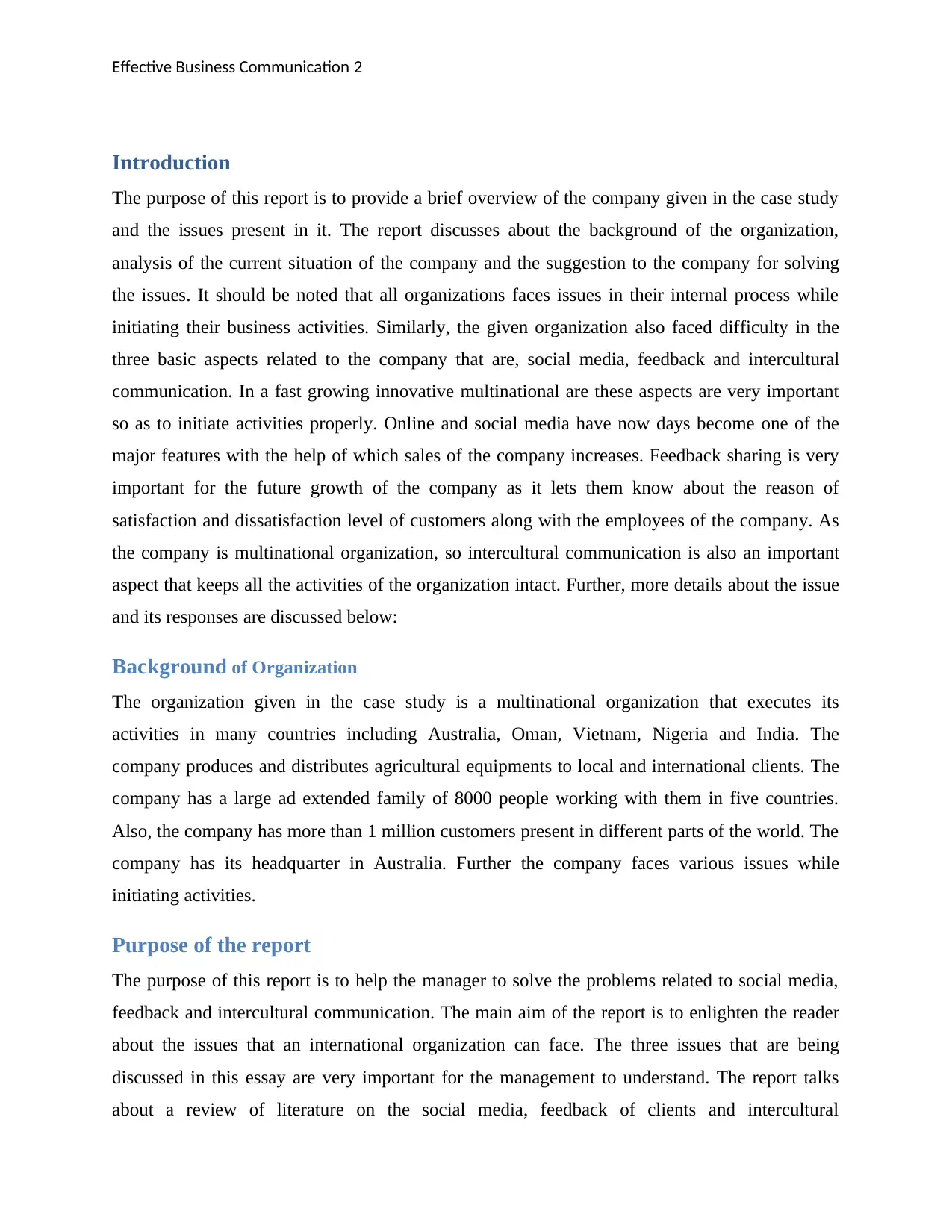
Effective Business Communication 2
Introduction
The purpose of this report is to provide a brief overview of the company given in the case study
and the issues present in it. The report discusses about the background of the organization,
analysis of the current situation of the company and the suggestion to the company for solving
the issues. It should be noted that all organizations faces issues in their internal process while
initiating their business activities. Similarly, the given organization also faced difficulty in the
three basic aspects related to the company that are, social media, feedback and intercultural
communication. In a fast growing innovative multinational are these aspects are very important
so as to initiate activities properly. Online and social media have now days become one of the
major features with the help of which sales of the company increases. Feedback sharing is very
important for the future growth of the company as it lets them know about the reason of
satisfaction and dissatisfaction level of customers along with the employees of the company. As
the company is multinational organization, so intercultural communication is also an important
aspect that keeps all the activities of the organization intact. Further, more details about the issue
and its responses are discussed below:
Background of Organization
The organization given in the case study is a multinational organization that executes its
activities in many countries including Australia, Oman, Vietnam, Nigeria and India. The
company produces and distributes agricultural equipments to local and international clients. The
company has a large ad extended family of 8000 people working with them in five countries.
Also, the company has more than 1 million customers present in different parts of the world. The
company has its headquarter in Australia. Further the company faces various issues while
initiating activities.
Purpose of the report
The purpose of this report is to help the manager to solve the problems related to social media,
feedback and intercultural communication. The main aim of the report is to enlighten the reader
about the issues that an international organization can face. The three issues that are being
discussed in this essay are very important for the management to understand. The report talks
about a review of literature on the social media, feedback of clients and intercultural
Introduction
The purpose of this report is to provide a brief overview of the company given in the case study
and the issues present in it. The report discusses about the background of the organization,
analysis of the current situation of the company and the suggestion to the company for solving
the issues. It should be noted that all organizations faces issues in their internal process while
initiating their business activities. Similarly, the given organization also faced difficulty in the
three basic aspects related to the company that are, social media, feedback and intercultural
communication. In a fast growing innovative multinational are these aspects are very important
so as to initiate activities properly. Online and social media have now days become one of the
major features with the help of which sales of the company increases. Feedback sharing is very
important for the future growth of the company as it lets them know about the reason of
satisfaction and dissatisfaction level of customers along with the employees of the company. As
the company is multinational organization, so intercultural communication is also an important
aspect that keeps all the activities of the organization intact. Further, more details about the issue
and its responses are discussed below:
Background of Organization
The organization given in the case study is a multinational organization that executes its
activities in many countries including Australia, Oman, Vietnam, Nigeria and India. The
company produces and distributes agricultural equipments to local and international clients. The
company has a large ad extended family of 8000 people working with them in five countries.
Also, the company has more than 1 million customers present in different parts of the world. The
company has its headquarter in Australia. Further the company faces various issues while
initiating activities.
Purpose of the report
The purpose of this report is to help the manager to solve the problems related to social media,
feedback and intercultural communication. The main aim of the report is to enlighten the reader
about the issues that an international organization can face. The three issues that are being
discussed in this essay are very important for the management to understand. The report talks
about a review of literature on the social media, feedback of clients and intercultural
⊘ This is a preview!⊘
Do you want full access?
Subscribe today to unlock all pages.

Trusted by 1+ million students worldwide
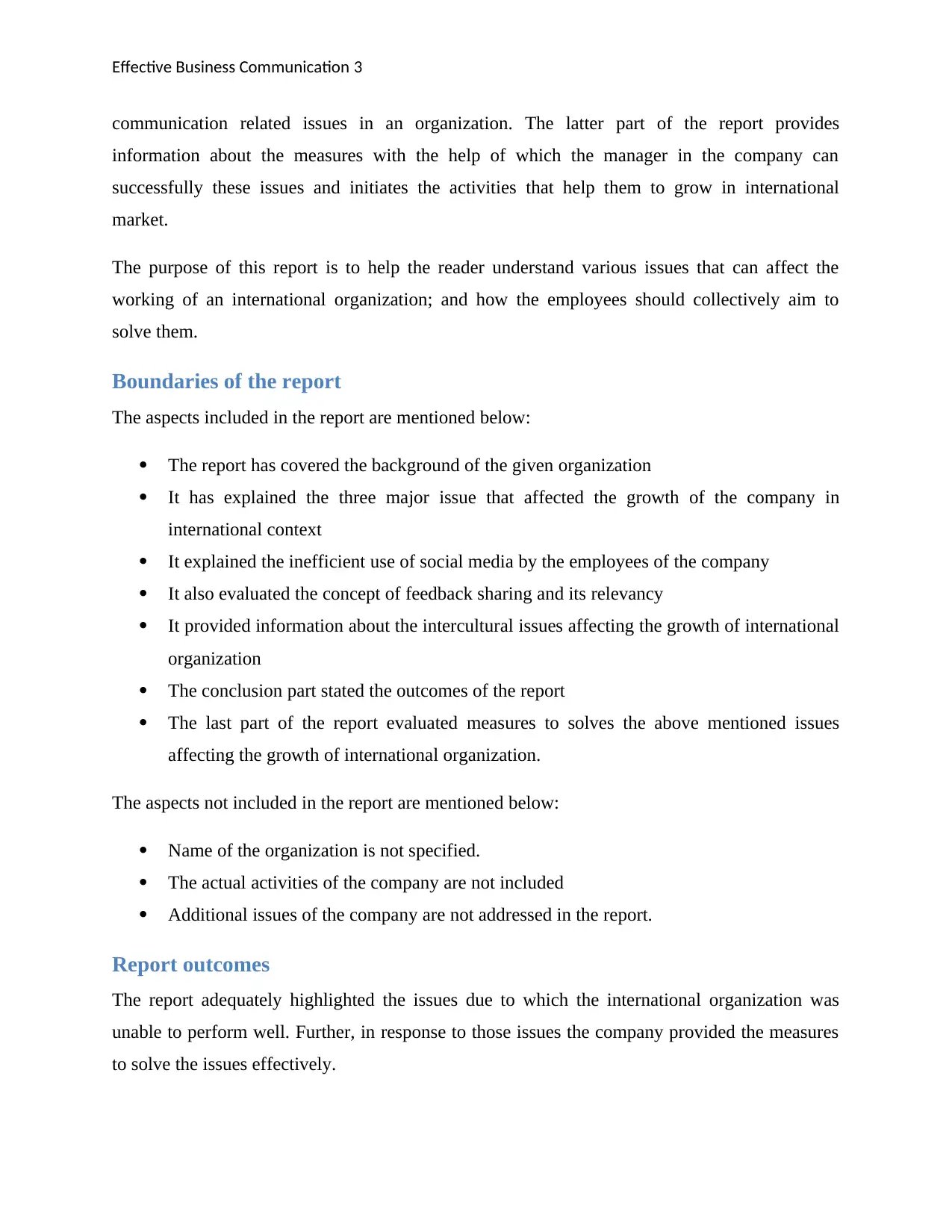
Effective Business Communication 3
communication related issues in an organization. The latter part of the report provides
information about the measures with the help of which the manager in the company can
successfully these issues and initiates the activities that help them to grow in international
market.
The purpose of this report is to help the reader understand various issues that can affect the
working of an international organization; and how the employees should collectively aim to
solve them.
Boundaries of the report
The aspects included in the report are mentioned below:
The report has covered the background of the given organization
It has explained the three major issue that affected the growth of the company in
international context
It explained the inefficient use of social media by the employees of the company
It also evaluated the concept of feedback sharing and its relevancy
It provided information about the intercultural issues affecting the growth of international
organization
The conclusion part stated the outcomes of the report
The last part of the report evaluated measures to solves the above mentioned issues
affecting the growth of international organization.
The aspects not included in the report are mentioned below:
Name of the organization is not specified.
The actual activities of the company are not included
Additional issues of the company are not addressed in the report.
Report outcomes
The report adequately highlighted the issues due to which the international organization was
unable to perform well. Further, in response to those issues the company provided the measures
to solve the issues effectively.
communication related issues in an organization. The latter part of the report provides
information about the measures with the help of which the manager in the company can
successfully these issues and initiates the activities that help them to grow in international
market.
The purpose of this report is to help the reader understand various issues that can affect the
working of an international organization; and how the employees should collectively aim to
solve them.
Boundaries of the report
The aspects included in the report are mentioned below:
The report has covered the background of the given organization
It has explained the three major issue that affected the growth of the company in
international context
It explained the inefficient use of social media by the employees of the company
It also evaluated the concept of feedback sharing and its relevancy
It provided information about the intercultural issues affecting the growth of international
organization
The conclusion part stated the outcomes of the report
The last part of the report evaluated measures to solves the above mentioned issues
affecting the growth of international organization.
The aspects not included in the report are mentioned below:
Name of the organization is not specified.
The actual activities of the company are not included
Additional issues of the company are not addressed in the report.
Report outcomes
The report adequately highlighted the issues due to which the international organization was
unable to perform well. Further, in response to those issues the company provided the measures
to solve the issues effectively.
Paraphrase This Document
Need a fresh take? Get an instant paraphrase of this document with our AI Paraphraser
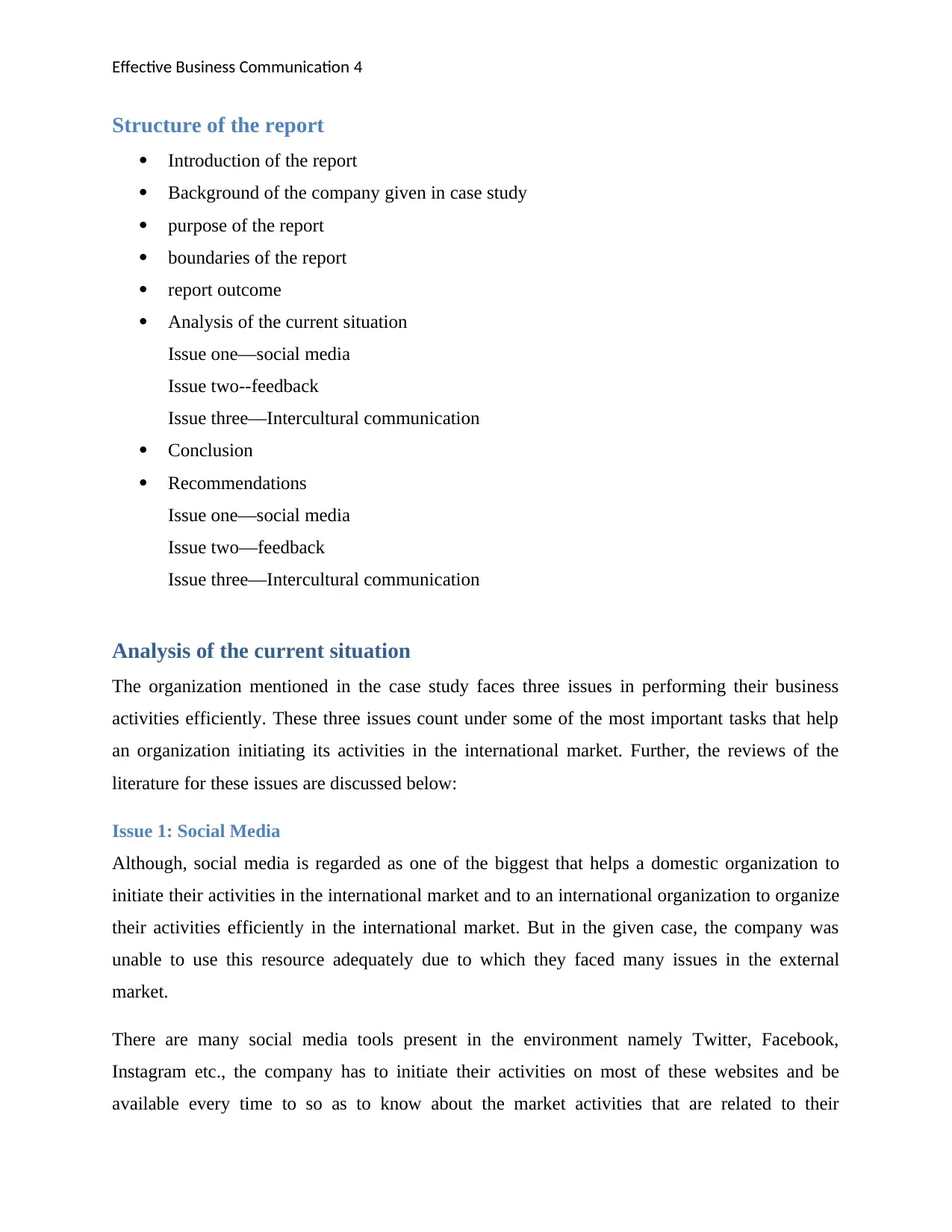
Effective Business Communication 4
Structure of the report
Introduction of the report
Background of the company given in case study
purpose of the report
boundaries of the report
report outcome
Analysis of the current situation
Issue one—social media
Issue two--feedback
Issue three—Intercultural communication
Conclusion
Recommendations
Issue one—social media
Issue two—feedback
Issue three—Intercultural communication
Analysis of the current situation
The organization mentioned in the case study faces three issues in performing their business
activities efficiently. These three issues count under some of the most important tasks that help
an organization initiating its activities in the international market. Further, the reviews of the
literature for these issues are discussed below:
Issue 1: Social Media
Although, social media is regarded as one of the biggest that helps a domestic organization to
initiate their activities in the international market and to an international organization to organize
their activities efficiently in the international market. But in the given case, the company was
unable to use this resource adequately due to which they faced many issues in the external
market.
There are many social media tools present in the environment namely Twitter, Facebook,
Instagram etc., the company has to initiate their activities on most of these websites and be
available every time to so as to know about the market activities that are related to their
Structure of the report
Introduction of the report
Background of the company given in case study
purpose of the report
boundaries of the report
report outcome
Analysis of the current situation
Issue one—social media
Issue two--feedback
Issue three—Intercultural communication
Conclusion
Recommendations
Issue one—social media
Issue two—feedback
Issue three—Intercultural communication
Analysis of the current situation
The organization mentioned in the case study faces three issues in performing their business
activities efficiently. These three issues count under some of the most important tasks that help
an organization initiating its activities in the international market. Further, the reviews of the
literature for these issues are discussed below:
Issue 1: Social Media
Although, social media is regarded as one of the biggest that helps a domestic organization to
initiate their activities in the international market and to an international organization to organize
their activities efficiently in the international market. But in the given case, the company was
unable to use this resource adequately due to which they faced many issues in the external
market.
There are many social media tools present in the environment namely Twitter, Facebook,
Instagram etc., the company has to initiate their activities on most of these websites and be
available every time to so as to know about the market activities that are related to their
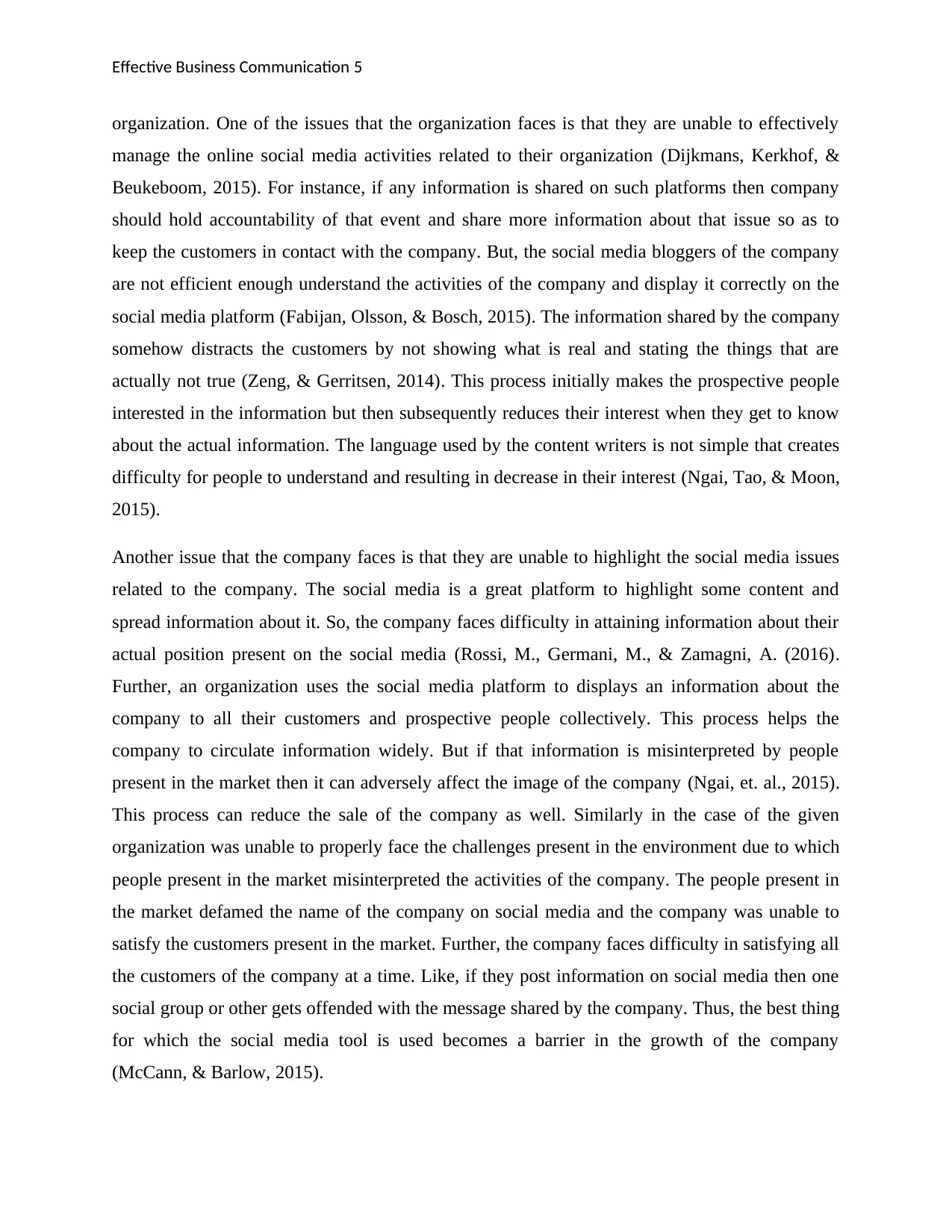
Effective Business Communication 5
organization. One of the issues that the organization faces is that they are unable to effectively
manage the online social media activities related to their organization (Dijkmans, Kerkhof, &
Beukeboom, 2015). For instance, if any information is shared on such platforms then company
should hold accountability of that event and share more information about that issue so as to
keep the customers in contact with the company. But, the social media bloggers of the company
are not efficient enough understand the activities of the company and display it correctly on the
social media platform (Fabijan, Olsson, & Bosch, 2015). The information shared by the company
somehow distracts the customers by not showing what is real and stating the things that are
actually not true (Zeng, & Gerritsen, 2014). This process initially makes the prospective people
interested in the information but then subsequently reduces their interest when they get to know
about the actual information. The language used by the content writers is not simple that creates
difficulty for people to understand and resulting in decrease in their interest (Ngai, Tao, & Moon,
2015).
Another issue that the company faces is that they are unable to highlight the social media issues
related to the company. The social media is a great platform to highlight some content and
spread information about it. So, the company faces difficulty in attaining information about their
actual position present on the social media (Rossi, M., Germani, M., & Zamagni, A. (2016).
Further, an organization uses the social media platform to displays an information about the
company to all their customers and prospective people collectively. This process helps the
company to circulate information widely. But if that information is misinterpreted by people
present in the market then it can adversely affect the image of the company (Ngai, et. al., 2015).
This process can reduce the sale of the company as well. Similarly in the case of the given
organization was unable to properly face the challenges present in the environment due to which
people present in the market misinterpreted the activities of the company. The people present in
the market defamed the name of the company on social media and the company was unable to
satisfy the customers present in the market. Further, the company faces difficulty in satisfying all
the customers of the company at a time. Like, if they post information on social media then one
social group or other gets offended with the message shared by the company. Thus, the best thing
for which the social media tool is used becomes a barrier in the growth of the company
(McCann, & Barlow, 2015).
organization. One of the issues that the organization faces is that they are unable to effectively
manage the online social media activities related to their organization (Dijkmans, Kerkhof, &
Beukeboom, 2015). For instance, if any information is shared on such platforms then company
should hold accountability of that event and share more information about that issue so as to
keep the customers in contact with the company. But, the social media bloggers of the company
are not efficient enough understand the activities of the company and display it correctly on the
social media platform (Fabijan, Olsson, & Bosch, 2015). The information shared by the company
somehow distracts the customers by not showing what is real and stating the things that are
actually not true (Zeng, & Gerritsen, 2014). This process initially makes the prospective people
interested in the information but then subsequently reduces their interest when they get to know
about the actual information. The language used by the content writers is not simple that creates
difficulty for people to understand and resulting in decrease in their interest (Ngai, Tao, & Moon,
2015).
Another issue that the company faces is that they are unable to highlight the social media issues
related to the company. The social media is a great platform to highlight some content and
spread information about it. So, the company faces difficulty in attaining information about their
actual position present on the social media (Rossi, M., Germani, M., & Zamagni, A. (2016).
Further, an organization uses the social media platform to displays an information about the
company to all their customers and prospective people collectively. This process helps the
company to circulate information widely. But if that information is misinterpreted by people
present in the market then it can adversely affect the image of the company (Ngai, et. al., 2015).
This process can reduce the sale of the company as well. Similarly in the case of the given
organization was unable to properly face the challenges present in the environment due to which
people present in the market misinterpreted the activities of the company. The people present in
the market defamed the name of the company on social media and the company was unable to
satisfy the customers present in the market. Further, the company faces difficulty in satisfying all
the customers of the company at a time. Like, if they post information on social media then one
social group or other gets offended with the message shared by the company. Thus, the best thing
for which the social media tool is used becomes a barrier in the growth of the company
(McCann, & Barlow, 2015).
⊘ This is a preview!⊘
Do you want full access?
Subscribe today to unlock all pages.

Trusted by 1+ million students worldwide
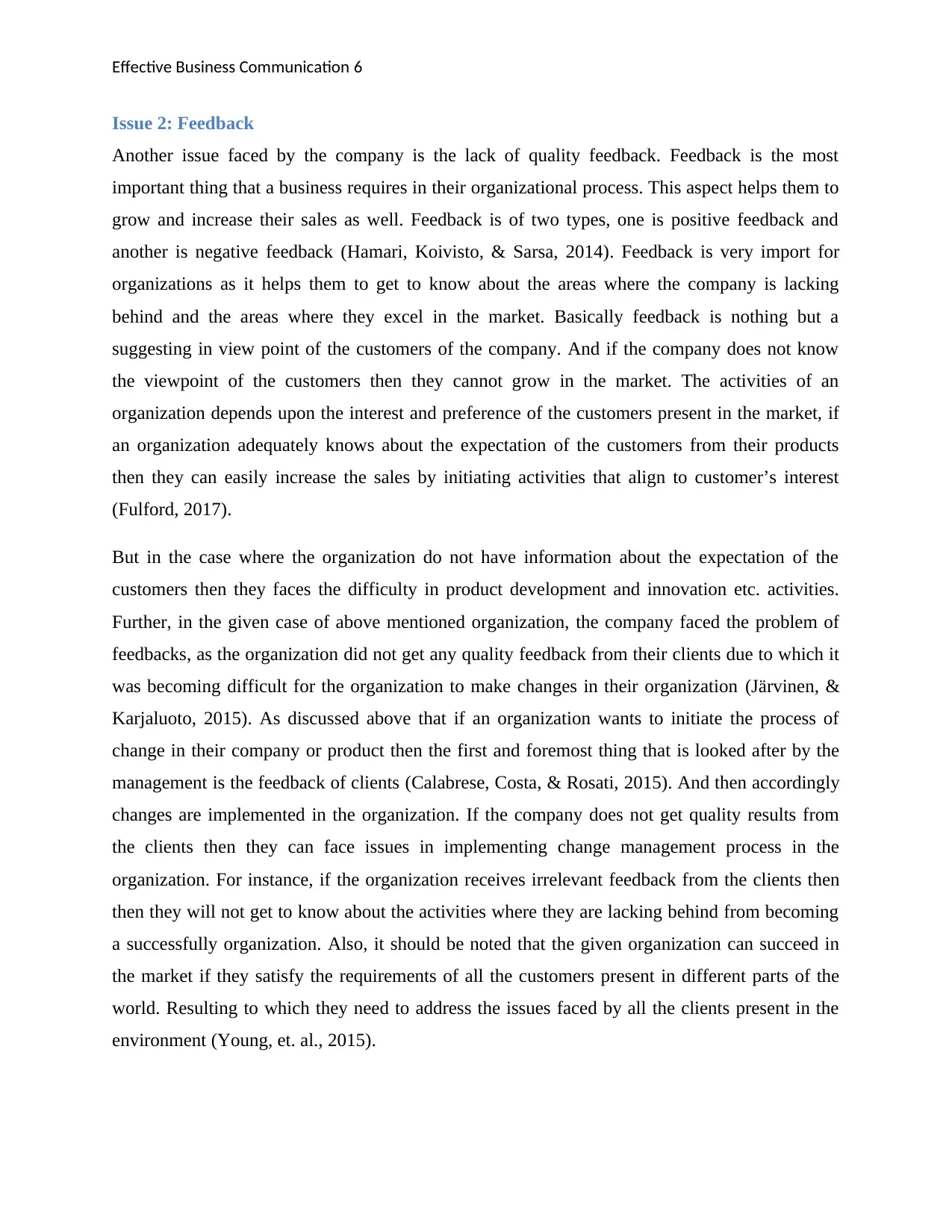
Effective Business Communication 6
Issue 2: Feedback
Another issue faced by the company is the lack of quality feedback. Feedback is the most
important thing that a business requires in their organizational process. This aspect helps them to
grow and increase their sales as well. Feedback is of two types, one is positive feedback and
another is negative feedback (Hamari, Koivisto, & Sarsa, 2014). Feedback is very import for
organizations as it helps them to get to know about the areas where the company is lacking
behind and the areas where they excel in the market. Basically feedback is nothing but a
suggesting in view point of the customers of the company. And if the company does not know
the viewpoint of the customers then they cannot grow in the market. The activities of an
organization depends upon the interest and preference of the customers present in the market, if
an organization adequately knows about the expectation of the customers from their products
then they can easily increase the sales by initiating activities that align to customer’s interest
(Fulford, 2017).
But in the case where the organization do not have information about the expectation of the
customers then they faces the difficulty in product development and innovation etc. activities.
Further, in the given case of above mentioned organization, the company faced the problem of
feedbacks, as the organization did not get any quality feedback from their clients due to which it
was becoming difficult for the organization to make changes in their organization (Järvinen, &
Karjaluoto, 2015). As discussed above that if an organization wants to initiate the process of
change in their company or product then the first and foremost thing that is looked after by the
management is the feedback of clients (Calabrese, Costa, & Rosati, 2015). And then accordingly
changes are implemented in the organization. If the company does not get quality results from
the clients then they can face issues in implementing change management process in the
organization. For instance, if the organization receives irrelevant feedback from the clients then
then they will not get to know about the activities where they are lacking behind from becoming
a successfully organization. Also, it should be noted that the given organization can succeed in
the market if they satisfy the requirements of all the customers present in different parts of the
world. Resulting to which they need to address the issues faced by all the clients present in the
environment (Young, et. al., 2015).
Issue 2: Feedback
Another issue faced by the company is the lack of quality feedback. Feedback is the most
important thing that a business requires in their organizational process. This aspect helps them to
grow and increase their sales as well. Feedback is of two types, one is positive feedback and
another is negative feedback (Hamari, Koivisto, & Sarsa, 2014). Feedback is very import for
organizations as it helps them to get to know about the areas where the company is lacking
behind and the areas where they excel in the market. Basically feedback is nothing but a
suggesting in view point of the customers of the company. And if the company does not know
the viewpoint of the customers then they cannot grow in the market. The activities of an
organization depends upon the interest and preference of the customers present in the market, if
an organization adequately knows about the expectation of the customers from their products
then they can easily increase the sales by initiating activities that align to customer’s interest
(Fulford, 2017).
But in the case where the organization do not have information about the expectation of the
customers then they faces the difficulty in product development and innovation etc. activities.
Further, in the given case of above mentioned organization, the company faced the problem of
feedbacks, as the organization did not get any quality feedback from their clients due to which it
was becoming difficult for the organization to make changes in their organization (Järvinen, &
Karjaluoto, 2015). As discussed above that if an organization wants to initiate the process of
change in their company or product then the first and foremost thing that is looked after by the
management is the feedback of clients (Calabrese, Costa, & Rosati, 2015). And then accordingly
changes are implemented in the organization. If the company does not get quality results from
the clients then they can face issues in implementing change management process in the
organization. For instance, if the organization receives irrelevant feedback from the clients then
then they will not get to know about the activities where they are lacking behind from becoming
a successfully organization. Also, it should be noted that the given organization can succeed in
the market if they satisfy the requirements of all the customers present in different parts of the
world. Resulting to which they need to address the issues faced by all the clients present in the
environment (Young, et. al., 2015).
Paraphrase This Document
Need a fresh take? Get an instant paraphrase of this document with our AI Paraphraser
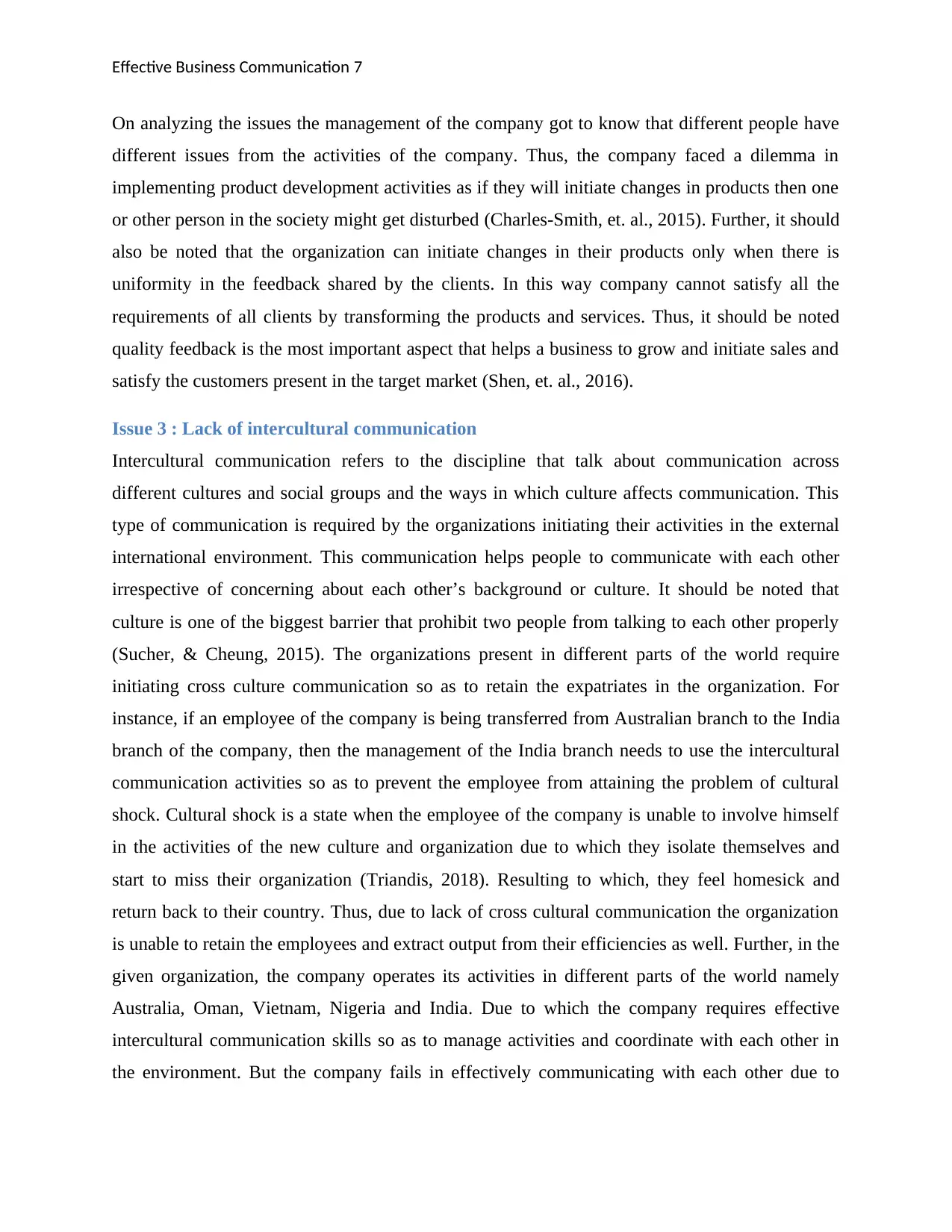
Effective Business Communication 7
On analyzing the issues the management of the company got to know that different people have
different issues from the activities of the company. Thus, the company faced a dilemma in
implementing product development activities as if they will initiate changes in products then one
or other person in the society might get disturbed (Charles-Smith, et. al., 2015). Further, it should
also be noted that the organization can initiate changes in their products only when there is
uniformity in the feedback shared by the clients. In this way company cannot satisfy all the
requirements of all clients by transforming the products and services. Thus, it should be noted
quality feedback is the most important aspect that helps a business to grow and initiate sales and
satisfy the customers present in the target market (Shen, et. al., 2016).
Issue 3 : Lack of intercultural communication
Intercultural communication refers to the discipline that talk about communication across
different cultures and social groups and the ways in which culture affects communication. This
type of communication is required by the organizations initiating their activities in the external
international environment. This communication helps people to communicate with each other
irrespective of concerning about each other’s background or culture. It should be noted that
culture is one of the biggest barrier that prohibit two people from talking to each other properly
(Sucher, & Cheung, 2015). The organizations present in different parts of the world require
initiating cross culture communication so as to retain the expatriates in the organization. For
instance, if an employee of the company is being transferred from Australian branch to the India
branch of the company, then the management of the India branch needs to use the intercultural
communication activities so as to prevent the employee from attaining the problem of cultural
shock. Cultural shock is a state when the employee of the company is unable to involve himself
in the activities of the new culture and organization due to which they isolate themselves and
start to miss their organization (Triandis, 2018). Resulting to which, they feel homesick and
return back to their country. Thus, due to lack of cross cultural communication the organization
is unable to retain the employees and extract output from their efficiencies as well. Further, in the
given organization, the company operates its activities in different parts of the world namely
Australia, Oman, Vietnam, Nigeria and India. Due to which the company requires effective
intercultural communication skills so as to manage activities and coordinate with each other in
the environment. But the company fails in effectively communicating with each other due to
On analyzing the issues the management of the company got to know that different people have
different issues from the activities of the company. Thus, the company faced a dilemma in
implementing product development activities as if they will initiate changes in products then one
or other person in the society might get disturbed (Charles-Smith, et. al., 2015). Further, it should
also be noted that the organization can initiate changes in their products only when there is
uniformity in the feedback shared by the clients. In this way company cannot satisfy all the
requirements of all clients by transforming the products and services. Thus, it should be noted
quality feedback is the most important aspect that helps a business to grow and initiate sales and
satisfy the customers present in the target market (Shen, et. al., 2016).
Issue 3 : Lack of intercultural communication
Intercultural communication refers to the discipline that talk about communication across
different cultures and social groups and the ways in which culture affects communication. This
type of communication is required by the organizations initiating their activities in the external
international environment. This communication helps people to communicate with each other
irrespective of concerning about each other’s background or culture. It should be noted that
culture is one of the biggest barrier that prohibit two people from talking to each other properly
(Sucher, & Cheung, 2015). The organizations present in different parts of the world require
initiating cross culture communication so as to retain the expatriates in the organization. For
instance, if an employee of the company is being transferred from Australian branch to the India
branch of the company, then the management of the India branch needs to use the intercultural
communication activities so as to prevent the employee from attaining the problem of cultural
shock. Cultural shock is a state when the employee of the company is unable to involve himself
in the activities of the new culture and organization due to which they isolate themselves and
start to miss their organization (Triandis, 2018). Resulting to which, they feel homesick and
return back to their country. Thus, due to lack of cross cultural communication the organization
is unable to retain the employees and extract output from their efficiencies as well. Further, in the
given organization, the company operates its activities in different parts of the world namely
Australia, Oman, Vietnam, Nigeria and India. Due to which the company requires effective
intercultural communication skills so as to manage activities and coordinate with each other in
the environment. But the company fails in effectively communicating with each other due to
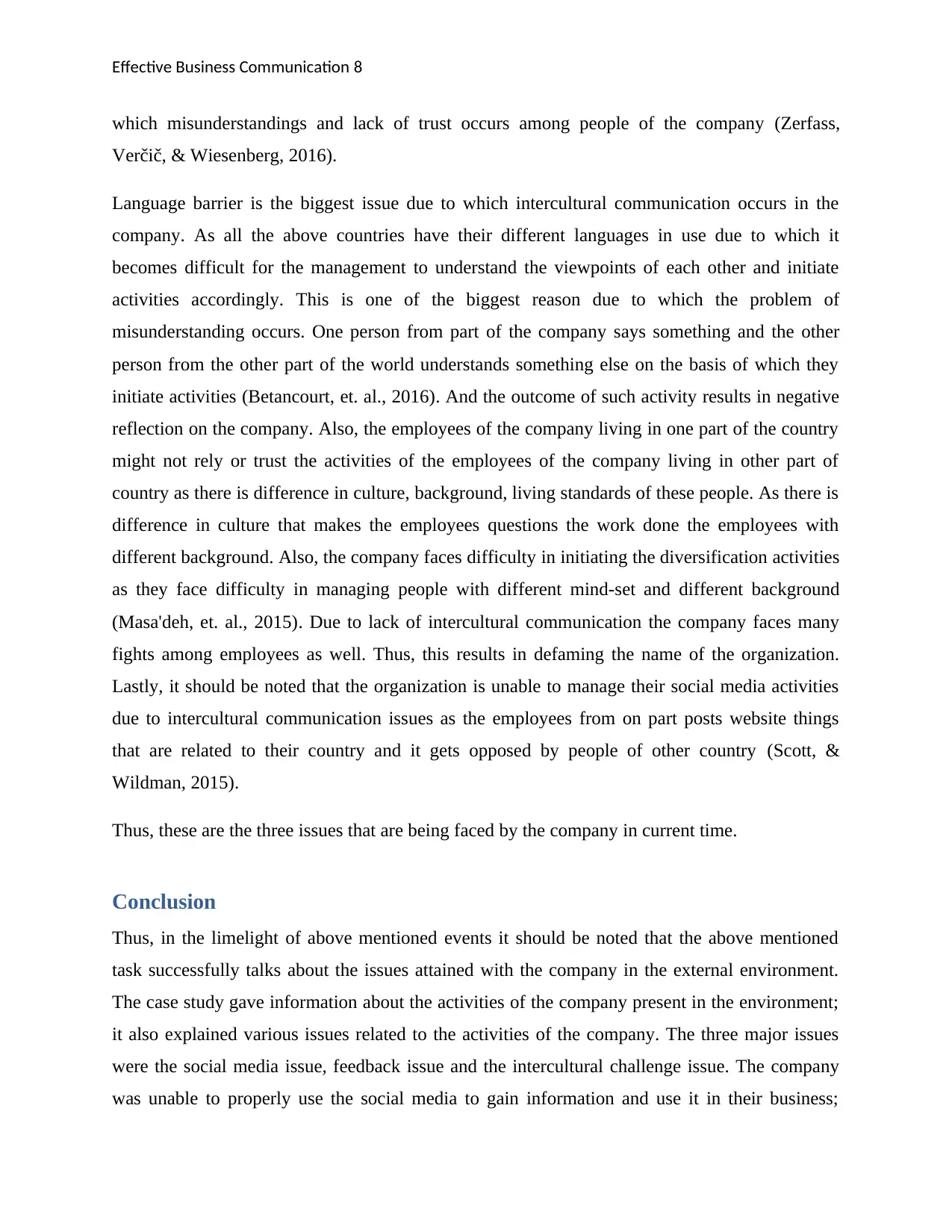
Effective Business Communication 8
which misunderstandings and lack of trust occurs among people of the company (Zerfass,
Verčič, & Wiesenberg, 2016).
Language barrier is the biggest issue due to which intercultural communication occurs in the
company. As all the above countries have their different languages in use due to which it
becomes difficult for the management to understand the viewpoints of each other and initiate
activities accordingly. This is one of the biggest reason due to which the problem of
misunderstanding occurs. One person from part of the company says something and the other
person from the other part of the world understands something else on the basis of which they
initiate activities (Betancourt, et. al., 2016). And the outcome of such activity results in negative
reflection on the company. Also, the employees of the company living in one part of the country
might not rely or trust the activities of the employees of the company living in other part of
country as there is difference in culture, background, living standards of these people. As there is
difference in culture that makes the employees questions the work done the employees with
different background. Also, the company faces difficulty in initiating the diversification activities
as they face difficulty in managing people with different mind-set and different background
(Masa'deh, et. al., 2015). Due to lack of intercultural communication the company faces many
fights among employees as well. Thus, this results in defaming the name of the organization.
Lastly, it should be noted that the organization is unable to manage their social media activities
due to intercultural communication issues as the employees from on part posts website things
that are related to their country and it gets opposed by people of other country (Scott, &
Wildman, 2015).
Thus, these are the three issues that are being faced by the company in current time.
Conclusion
Thus, in the limelight of above mentioned events it should be noted that the above mentioned
task successfully talks about the issues attained with the company in the external environment.
The case study gave information about the activities of the company present in the environment;
it also explained various issues related to the activities of the company. The three major issues
were the social media issue, feedback issue and the intercultural challenge issue. The company
was unable to properly use the social media to gain information and use it in their business;
which misunderstandings and lack of trust occurs among people of the company (Zerfass,
Verčič, & Wiesenberg, 2016).
Language barrier is the biggest issue due to which intercultural communication occurs in the
company. As all the above countries have their different languages in use due to which it
becomes difficult for the management to understand the viewpoints of each other and initiate
activities accordingly. This is one of the biggest reason due to which the problem of
misunderstanding occurs. One person from part of the company says something and the other
person from the other part of the world understands something else on the basis of which they
initiate activities (Betancourt, et. al., 2016). And the outcome of such activity results in negative
reflection on the company. Also, the employees of the company living in one part of the country
might not rely or trust the activities of the employees of the company living in other part of
country as there is difference in culture, background, living standards of these people. As there is
difference in culture that makes the employees questions the work done the employees with
different background. Also, the company faces difficulty in initiating the diversification activities
as they face difficulty in managing people with different mind-set and different background
(Masa'deh, et. al., 2015). Due to lack of intercultural communication the company faces many
fights among employees as well. Thus, this results in defaming the name of the organization.
Lastly, it should be noted that the organization is unable to manage their social media activities
due to intercultural communication issues as the employees from on part posts website things
that are related to their country and it gets opposed by people of other country (Scott, &
Wildman, 2015).
Thus, these are the three issues that are being faced by the company in current time.
Conclusion
Thus, in the limelight of above mentioned events it should be noted that the above mentioned
task successfully talks about the issues attained with the company in the external environment.
The case study gave information about the activities of the company present in the environment;
it also explained various issues related to the activities of the company. The three major issues
were the social media issue, feedback issue and the intercultural challenge issue. The company
was unable to properly use the social media to gain information and use it in their business;
⊘ This is a preview!⊘
Do you want full access?
Subscribe today to unlock all pages.

Trusted by 1+ million students worldwide
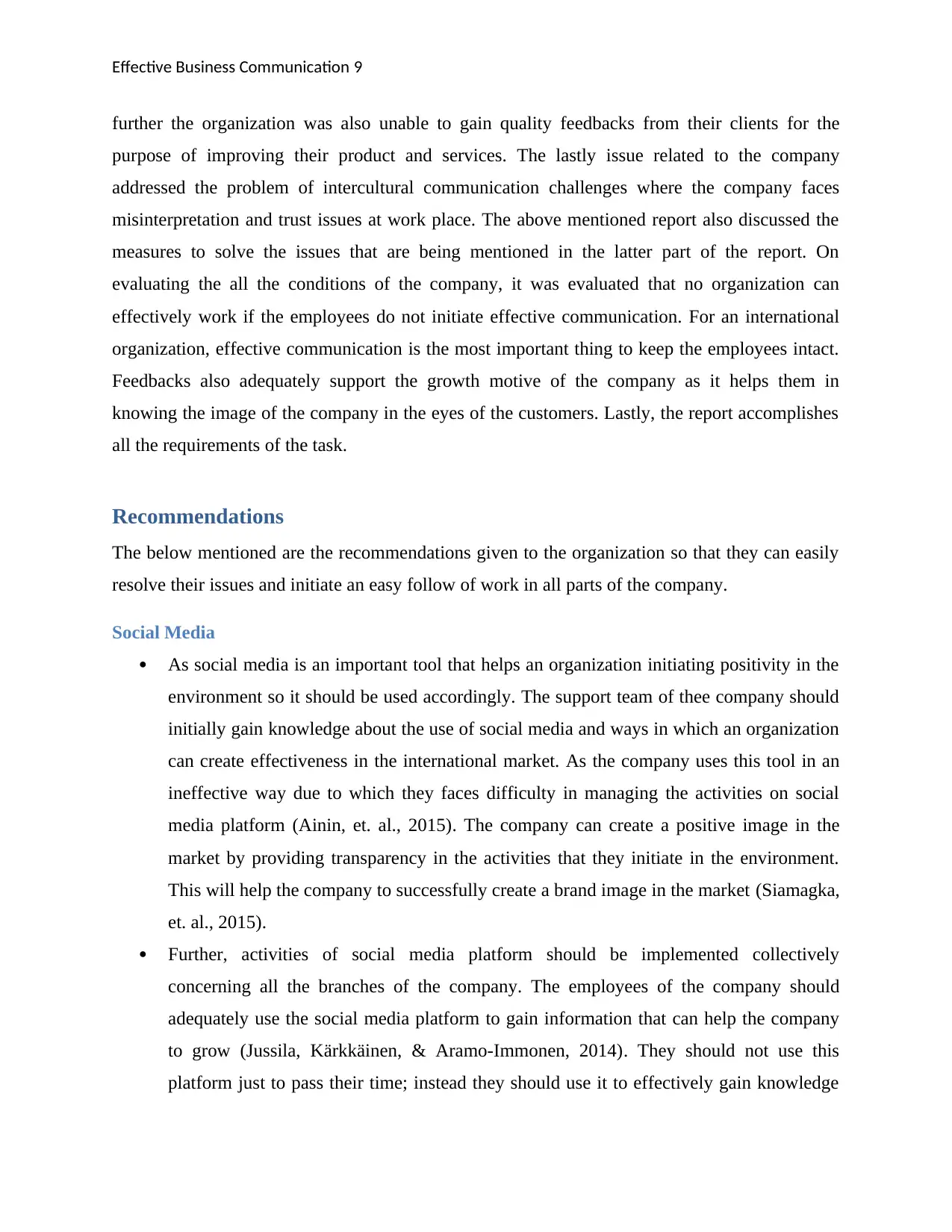
Effective Business Communication 9
further the organization was also unable to gain quality feedbacks from their clients for the
purpose of improving their product and services. The lastly issue related to the company
addressed the problem of intercultural communication challenges where the company faces
misinterpretation and trust issues at work place. The above mentioned report also discussed the
measures to solve the issues that are being mentioned in the latter part of the report. On
evaluating the all the conditions of the company, it was evaluated that no organization can
effectively work if the employees do not initiate effective communication. For an international
organization, effective communication is the most important thing to keep the employees intact.
Feedbacks also adequately support the growth motive of the company as it helps them in
knowing the image of the company in the eyes of the customers. Lastly, the report accomplishes
all the requirements of the task.
Recommendations
The below mentioned are the recommendations given to the organization so that they can easily
resolve their issues and initiate an easy follow of work in all parts of the company.
Social Media
As social media is an important tool that helps an organization initiating positivity in the
environment so it should be used accordingly. The support team of thee company should
initially gain knowledge about the use of social media and ways in which an organization
can create effectiveness in the international market. As the company uses this tool in an
ineffective way due to which they faces difficulty in managing the activities on social
media platform (Ainin, et. al., 2015). The company can create a positive image in the
market by providing transparency in the activities that they initiate in the environment.
This will help the company to successfully create a brand image in the market (Siamagka,
et. al., 2015).
Further, activities of social media platform should be implemented collectively
concerning all the branches of the company. The employees of the company should
adequately use the social media platform to gain information that can help the company
to grow (Jussila, Kärkkäinen, & Aramo-Immonen, 2014). They should not use this
platform just to pass their time; instead they should use it to effectively gain knowledge
further the organization was also unable to gain quality feedbacks from their clients for the
purpose of improving their product and services. The lastly issue related to the company
addressed the problem of intercultural communication challenges where the company faces
misinterpretation and trust issues at work place. The above mentioned report also discussed the
measures to solve the issues that are being mentioned in the latter part of the report. On
evaluating the all the conditions of the company, it was evaluated that no organization can
effectively work if the employees do not initiate effective communication. For an international
organization, effective communication is the most important thing to keep the employees intact.
Feedbacks also adequately support the growth motive of the company as it helps them in
knowing the image of the company in the eyes of the customers. Lastly, the report accomplishes
all the requirements of the task.
Recommendations
The below mentioned are the recommendations given to the organization so that they can easily
resolve their issues and initiate an easy follow of work in all parts of the company.
Social Media
As social media is an important tool that helps an organization initiating positivity in the
environment so it should be used accordingly. The support team of thee company should
initially gain knowledge about the use of social media and ways in which an organization
can create effectiveness in the international market. As the company uses this tool in an
ineffective way due to which they faces difficulty in managing the activities on social
media platform (Ainin, et. al., 2015). The company can create a positive image in the
market by providing transparency in the activities that they initiate in the environment.
This will help the company to successfully create a brand image in the market (Siamagka,
et. al., 2015).
Further, activities of social media platform should be implemented collectively
concerning all the branches of the company. The employees of the company should
adequately use the social media platform to gain information that can help the company
to grow (Jussila, Kärkkäinen, & Aramo-Immonen, 2014). They should not use this
platform just to pass their time; instead they should use it to effectively gain knowledge
Paraphrase This Document
Need a fresh take? Get an instant paraphrase of this document with our AI Paraphraser
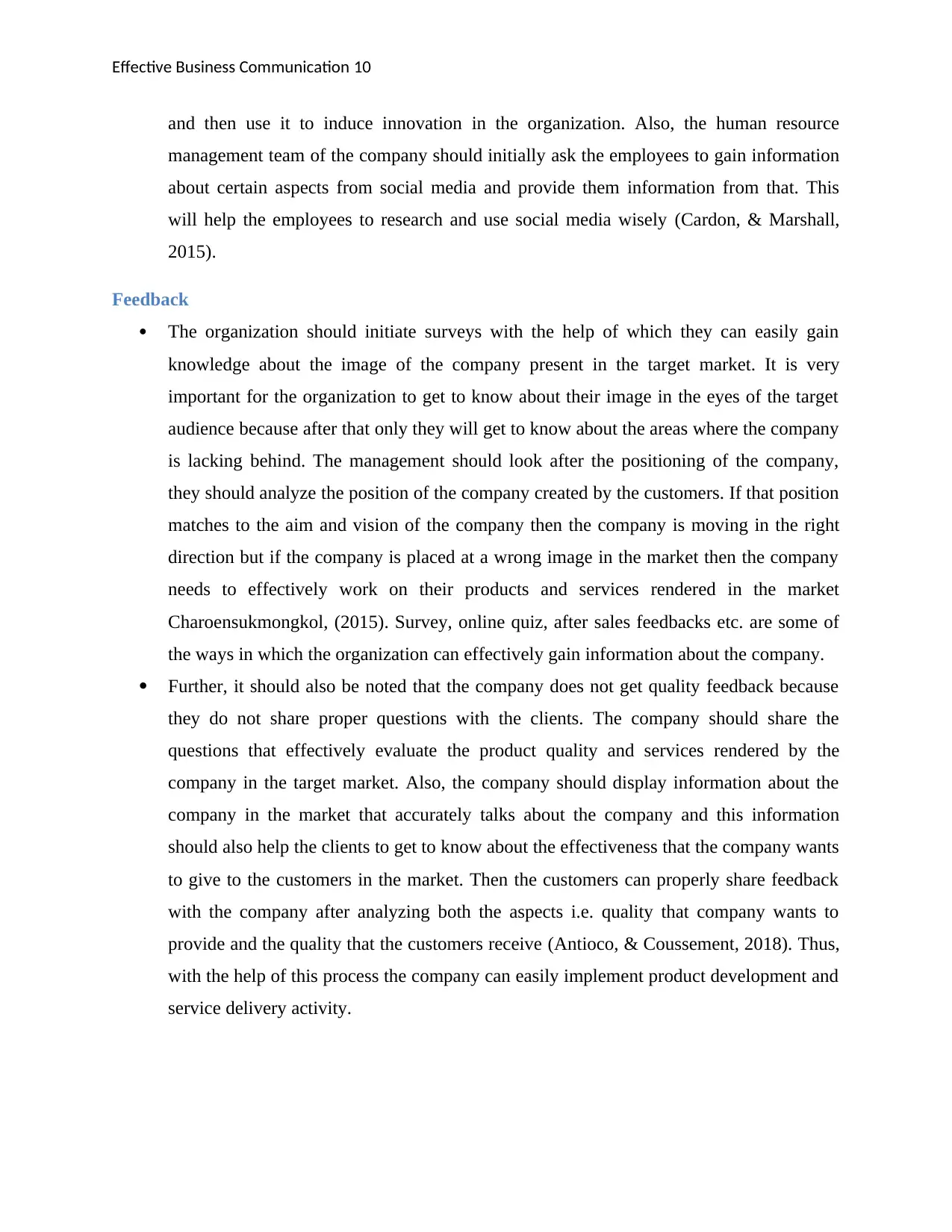
Effective Business Communication 10
and then use it to induce innovation in the organization. Also, the human resource
management team of the company should initially ask the employees to gain information
about certain aspects from social media and provide them information from that. This
will help the employees to research and use social media wisely (Cardon, & Marshall,
2015).
Feedback
The organization should initiate surveys with the help of which they can easily gain
knowledge about the image of the company present in the target market. It is very
important for the organization to get to know about their image in the eyes of the target
audience because after that only they will get to know about the areas where the company
is lacking behind. The management should look after the positioning of the company,
they should analyze the position of the company created by the customers. If that position
matches to the aim and vision of the company then the company is moving in the right
direction but if the company is placed at a wrong image in the market then the company
needs to effectively work on their products and services rendered in the market
Charoensukmongkol, (2015). Survey, online quiz, after sales feedbacks etc. are some of
the ways in which the organization can effectively gain information about the company.
Further, it should also be noted that the company does not get quality feedback because
they do not share proper questions with the clients. The company should share the
questions that effectively evaluate the product quality and services rendered by the
company in the target market. Also, the company should display information about the
company in the market that accurately talks about the company and this information
should also help the clients to get to know about the effectiveness that the company wants
to give to the customers in the market. Then the customers can properly share feedback
with the company after analyzing both the aspects i.e. quality that company wants to
provide and the quality that the customers receive (Antioco, & Coussement, 2018). Thus,
with the help of this process the company can easily implement product development and
service delivery activity.
and then use it to induce innovation in the organization. Also, the human resource
management team of the company should initially ask the employees to gain information
about certain aspects from social media and provide them information from that. This
will help the employees to research and use social media wisely (Cardon, & Marshall,
2015).
Feedback
The organization should initiate surveys with the help of which they can easily gain
knowledge about the image of the company present in the target market. It is very
important for the organization to get to know about their image in the eyes of the target
audience because after that only they will get to know about the areas where the company
is lacking behind. The management should look after the positioning of the company,
they should analyze the position of the company created by the customers. If that position
matches to the aim and vision of the company then the company is moving in the right
direction but if the company is placed at a wrong image in the market then the company
needs to effectively work on their products and services rendered in the market
Charoensukmongkol, (2015). Survey, online quiz, after sales feedbacks etc. are some of
the ways in which the organization can effectively gain information about the company.
Further, it should also be noted that the company does not get quality feedback because
they do not share proper questions with the clients. The company should share the
questions that effectively evaluate the product quality and services rendered by the
company in the target market. Also, the company should display information about the
company in the market that accurately talks about the company and this information
should also help the clients to get to know about the effectiveness that the company wants
to give to the customers in the market. Then the customers can properly share feedback
with the company after analyzing both the aspects i.e. quality that company wants to
provide and the quality that the customers receive (Antioco, & Coussement, 2018). Thus,
with the help of this process the company can easily implement product development and
service delivery activity.
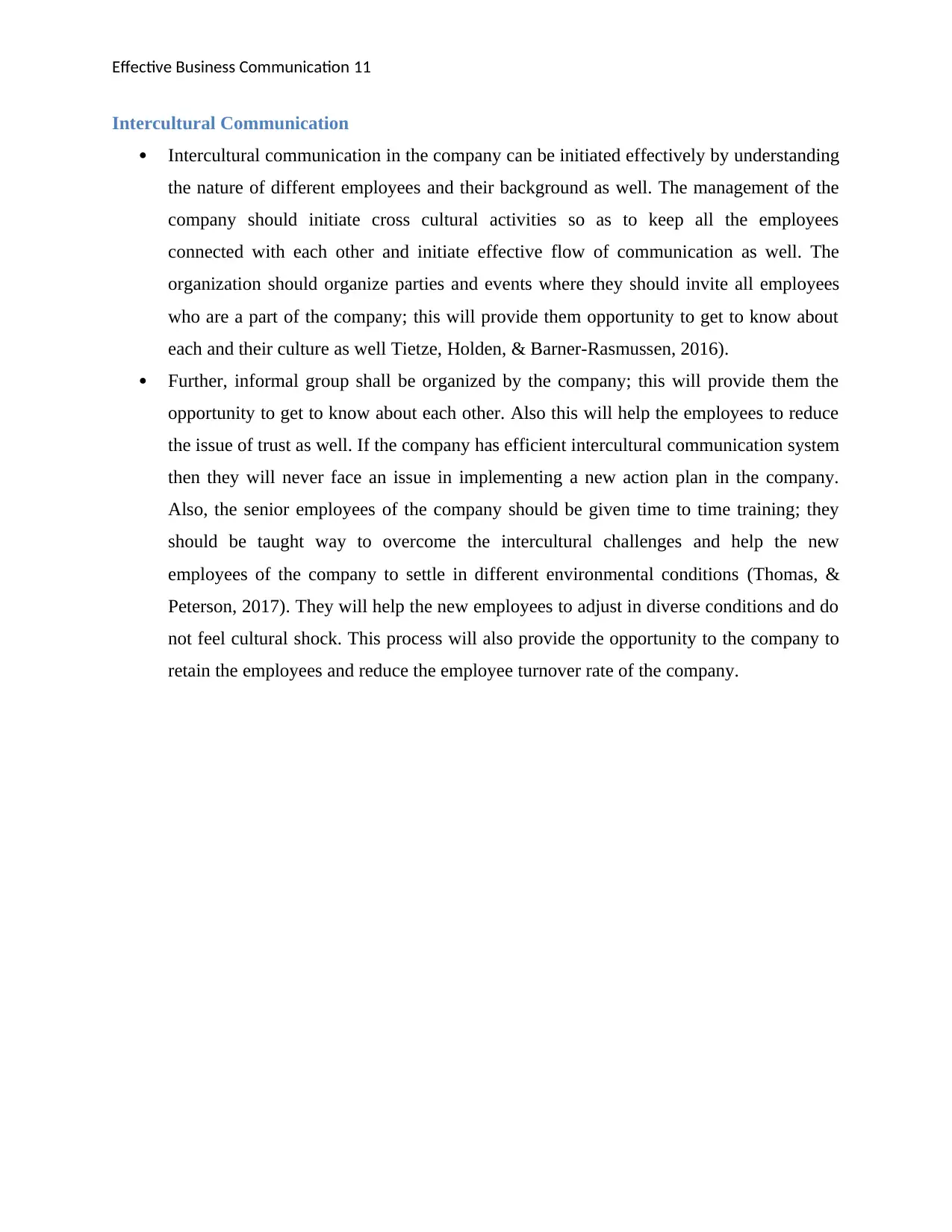
Effective Business Communication 11
Intercultural Communication
Intercultural communication in the company can be initiated effectively by understanding
the nature of different employees and their background as well. The management of the
company should initiate cross cultural activities so as to keep all the employees
connected with each other and initiate effective flow of communication as well. The
organization should organize parties and events where they should invite all employees
who are a part of the company; this will provide them opportunity to get to know about
each and their culture as well Tietze, Holden, & Barner-Rasmussen, 2016).
Further, informal group shall be organized by the company; this will provide them the
opportunity to get to know about each other. Also this will help the employees to reduce
the issue of trust as well. If the company has efficient intercultural communication system
then they will never face an issue in implementing a new action plan in the company.
Also, the senior employees of the company should be given time to time training; they
should be taught way to overcome the intercultural challenges and help the new
employees of the company to settle in different environmental conditions (Thomas, &
Peterson, 2017). They will help the new employees to adjust in diverse conditions and do
not feel cultural shock. This process will also provide the opportunity to the company to
retain the employees and reduce the employee turnover rate of the company.
Intercultural Communication
Intercultural communication in the company can be initiated effectively by understanding
the nature of different employees and their background as well. The management of the
company should initiate cross cultural activities so as to keep all the employees
connected with each other and initiate effective flow of communication as well. The
organization should organize parties and events where they should invite all employees
who are a part of the company; this will provide them opportunity to get to know about
each and their culture as well Tietze, Holden, & Barner-Rasmussen, 2016).
Further, informal group shall be organized by the company; this will provide them the
opportunity to get to know about each other. Also this will help the employees to reduce
the issue of trust as well. If the company has efficient intercultural communication system
then they will never face an issue in implementing a new action plan in the company.
Also, the senior employees of the company should be given time to time training; they
should be taught way to overcome the intercultural challenges and help the new
employees of the company to settle in different environmental conditions (Thomas, &
Peterson, 2017). They will help the new employees to adjust in diverse conditions and do
not feel cultural shock. This process will also provide the opportunity to the company to
retain the employees and reduce the employee turnover rate of the company.
⊘ This is a preview!⊘
Do you want full access?
Subscribe today to unlock all pages.

Trusted by 1+ million students worldwide
1 out of 15
Related Documents
Your All-in-One AI-Powered Toolkit for Academic Success.
+13062052269
info@desklib.com
Available 24*7 on WhatsApp / Email
![[object Object]](/_next/static/media/star-bottom.7253800d.svg)
Unlock your academic potential
Copyright © 2020–2025 A2Z Services. All Rights Reserved. Developed and managed by ZUCOL.





